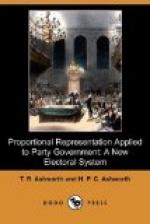But the assumed condition must be rigidly complied with; each elector must express his honest preferences. Whether he will do so or not depends upon the circumstances. Laplace recognized this element of human nature, and declared that if electors are swayed by other considerations independent of the merit of the candidates the system would not apply. For instance, if the candidates are the nominees of a number of independent sections, each of which is anxious only to secure the return of its own candidate, and to defeat those who stand most in his way, the tendency will be general to place the more popular candidates, those whose success is most feared, at the bottom of the list, so as to give them as few marks as possible. The result would be to favour mediocre men, or even in extreme cases the most inferior.
Practically, therefore, the system is not applicable where any of the electors are personally interested in the result. If a number of judges were called on to decide the relative merits of several essays or prize designs, and the competitors’ names were not known to them, the system might be used. But even in such a case a simpler method is available; for, although it may be difficult to pick out the best, it is generally easy to agree upon the worst. It is usual, then, to gradually eliminate the worst, and when the number is reduced to two to take the decision of the majority.
This process of elimination may be, however, combined with the preferential system, and the result is more accurate than if one count only be made. At the first count the candidate with the fewest marks would be eliminated and his name struck out on all the papers. All those under him on each paper would then go up one point in order of favour, and further counts would be held, eliminating the lowest candidate each time till the candidates were reduced to the number desired. This method is very complicated, and involves a great amount of trouble.




